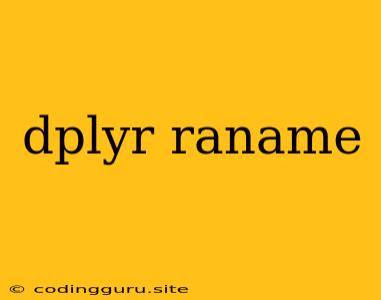Renaming Columns in dplyr: A Comprehensive Guide
When working with data in R, you often need to rename columns for clarity, consistency, or simply to align with your preferred naming conventions. dplyr, a popular package for data manipulation, offers a powerful and intuitive way to achieve this through the rename() function. In this guide, we will delve into the world of renaming columns in dplyr, covering various scenarios and practical examples.
Why Rename Columns?
Renaming columns in your data frame is crucial for a number of reasons:
- Clarity: Replacing cryptic or ambiguous column names with clear and descriptive ones improves data readability and understanding.
- Consistency: Maintaining consistent naming conventions across multiple datasets ensures seamless integration and analysis.
- Avoid Conflicts: Renaming columns can help avoid conflicts with existing variables or functions, especially in complex data manipulations.
The rename() Function in dplyr
The rename() function in dplyr provides a convenient and flexible way to rename columns in your data frame. It accepts a series of "old name = new name" pairs, allowing you to change the names of specific columns within your dataset.
Example:
Let's illustrate this with a simple example. Suppose you have a data frame called df with columns named "age" and "height". You want to rename them to "Age" and "Height" respectively.
library(dplyr)
# Create a sample data frame
df <- data.frame(age = c(25, 30, 28), height = c(170, 180, 175))
# Rename the columns
df <- rename(df, Age = age, Height = height)
# Print the renamed data frame
print(df)
Output:
Age Height
1 25 170
2 30 180
3 28 175
As you can see, the rename() function effectively renamed the columns "age" and "height" to "Age" and "Height" in our data frame.
Renaming Multiple Columns
You can rename multiple columns simultaneously within a single rename() function. Simply provide a series of "old name = new name" pairs separated by commas.
Example:
# Create a sample data frame with multiple columns
df <- data.frame(age = c(25, 30, 28), height = c(170, 180, 175), weight = c(70, 80, 75))
# Rename multiple columns
df <- rename(df, Age = age, Height = height, Weight = weight)
# Print the renamed data frame
print(df)
Output:
Age Height Weight
1 25 170 70
2 30 180 80
3 28 175 75
Renaming with mutate()
While rename() is the dedicated function for column renaming, you can achieve similar results using the mutate() function in dplyr. This is particularly useful if you need to perform other data manipulations alongside renaming.
Example:
# Create a sample data frame
df <- data.frame(age = c(25, 30, 28), height = c(170, 180, 175))
# Rename the column 'age' to 'Age' and calculate BMI
df <- mutate(df, Age = age, BMI = weight / (height/100)^2)
# Print the modified data frame
print(df)
Output:
age height BMI
1 25 170 NA
2 30 180 NA
3 28 175 NA
Tips for Effective Column Renaming:
- Use Descriptive Names: Choose names that clearly indicate the content of each column.
- Follow Conventions: Adhere to established naming conventions within your project or organization.
- Avoid Reserved Keywords: Avoid using names that conflict with existing R functions or variables.
Conclusion:
The rename() function in dplyr offers a powerful and intuitive way to rename columns in your data frames. By mastering this function, you can enhance the clarity, consistency, and efficiency of your data analysis workflow.
